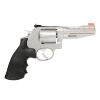My understanding is that Smith & Wesson introduced their L frame size in the early 1980's as a response to at least the perception of the problems with the use of 357 Magnum ammunition in K frame guns. This is pretty much the same thing as Palladan and wcwhitey say above. Now comes the less certain stuff:
I also understand that the L frame is
very similar to the pre-war Colt Official Police frame size. Colt actually made two 6 shot 38 Special revolvers for a long time: the small frame Police Positive/Detective Special, and the medium frame Official Police.
The reason that the K frame had trouble with 357 Magnum and the Colt Official Police did not was because the K frame was designed around the 38 Special cartridge. Colt designed the predecessor of the Official Police, the Army Special around a now long-gone cartridge called 41 Long Colt. The switch from Army Special to Official Police was a change in name only, for marketing purposes, with no significant change to the gun.
41 Long Colt, confusingly did not use 41 or even a 40 caliber bullets, but .386 inch, whereas 38 Special and its descendant, the 357 Magnum used .357 inch (hence the name, obviously). This .029 difference resulted, of course, in a slightly larger gun than the K frame, but apparently that was enough to make a significant difference in durability when both guns were offered in 357 Magnum.
The renowned Colt Python is an Official Police at heart. And the S&W L frame is more or less the same size, although the internal mechanism is entirely different, so it is a very different gun elsewise.
Well, I think I have created enough opportunities for people to set me straight for one post.











